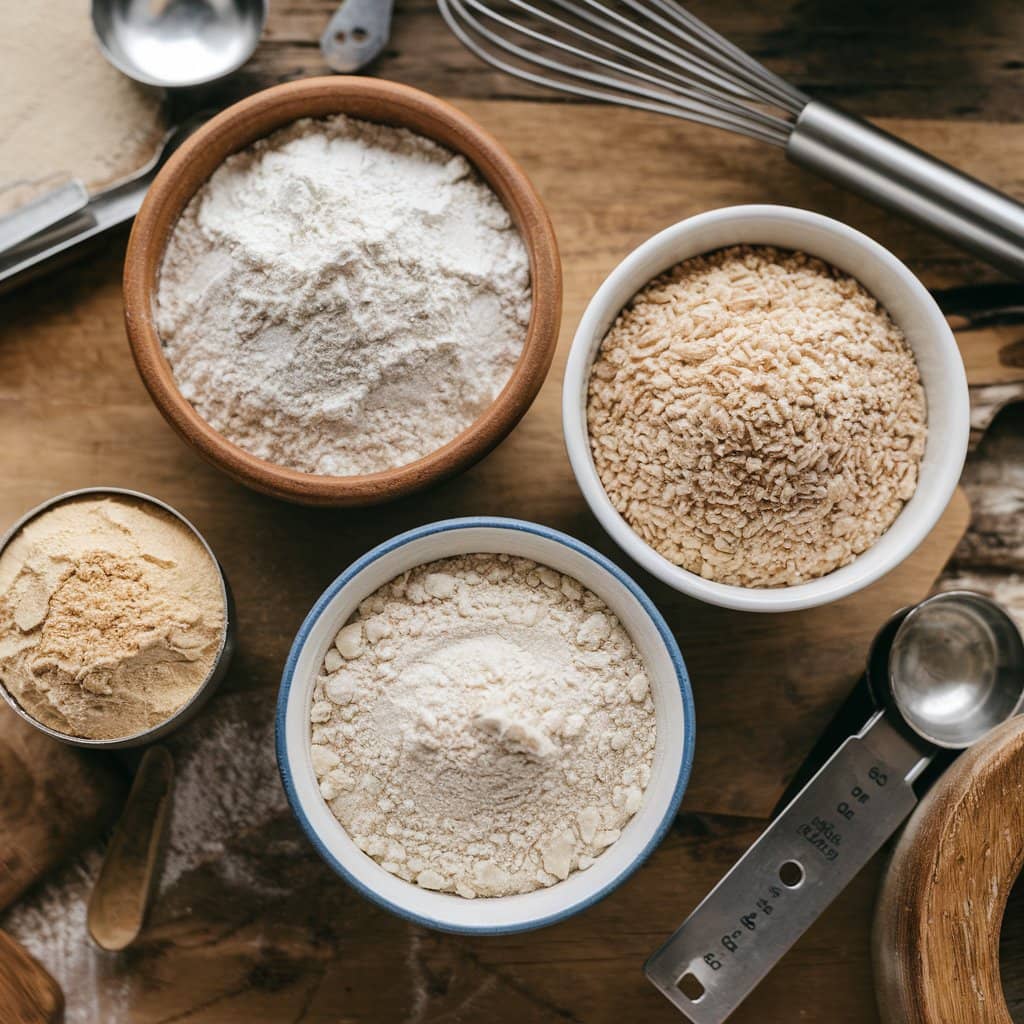Crepes are a versatile and beloved dish worldwide, offering endless possibilities for sweet or savory fillings. But what is the best flour for crepes? Choosing the right flour is essential to achieve the perfect texture, flexibility, and flavor. In this article, we’ll explore the top flours for making crepes, their unique qualities, and how to select the best one for your recipe.
Table of contents
What Is the Best Flour for Crepes? Understanding Different Types of Crepe Flours
When making crepes, choosing the right flour is crucial for achieving the perfect texture, flavor, and flexibility. Each type of flour has specific characteristics that affect the crepe’s taste, structure, and cooking process. Here’s a closer look at common flour types used in crepe-making:
Is All-Purpose Flour the Best Flour for Crepes? Pros and Cons
All-purpose flour is the most commonly used flour for crepes due to its versatility. With a moderate protein content (about 10-12%), it balances tenderness and structure well. It creates crepes that are light yet sturdy enough to hold various fillings without tearing.
Best Use: Sweet or savory crepes.
Texture Result: Smooth, light, and flexible crepes.
Why Cake Flour Might Be the Best Flour for Crepes
Cake flour is milled from soft wheat and has a lower protein content (about 8%). It produces extra-tender and delicate crepes. Its fine texture helps create thin, almost paper-like crepes.
Best Use: Sweet crepes, dessert-focused recipes.
Texture Result: Soft, tender, and melt-in-your-mouth crepes.
Can Pastry Flour Be the Best Flour for Crepes?
Pastry flour falls between all-purpose and cake flour, with a protein content of about 9%. It delivers light and tender crepes while maintaining enough structure for easy flipping and folding.
Best Use: Both sweet and savory crepes.
Texture Result: Balanced tenderness and flexibility.
Whole Wheat Flour
Whole wheat flour has a higher protein content and more fiber, creating a denser crepe. Its nutty flavor pairs well with hearty fillings but can result in a heavier texture if not combined with lighter flours.
Best Use: Savory crepes with robust fillings.
Texture Result: Nutty, slightly dense, and hearty.
Buckwheat Flour
Buckwheat flour is traditional in making savory crepes, especially in French cuisine. It is gluten-free, highly nutritious, and has a distinct earthy flavor. It works well in savory galettes but may need to be mixed with another flour for better flexibility.
Best Use: Savory crepes like galettes.
Texture Result: Nutty, earthy, and slightly crispy edges.
Gluten-Free Options
For those with gluten sensitivities, there are excellent gluten-free flour alternatives such as rice flour, almond flour, and chickpea flour. These flours often need to be combined with starches like tapioca or potato starch for better elasticity and smoothness.
Best Use: Gluten-free crepes.
Texture Result: Varies depending on flour blend.
What Is the Best Flour for Sweet Crepes? Top Recommendations
Sweet crepes are often light, soft, and slightly chewy, perfect for fillings like fruit, chocolate, or whipped cream. The right flour ensures a smooth batter that spreads evenly on the pan. Here are the best flours for making sweet crepes:
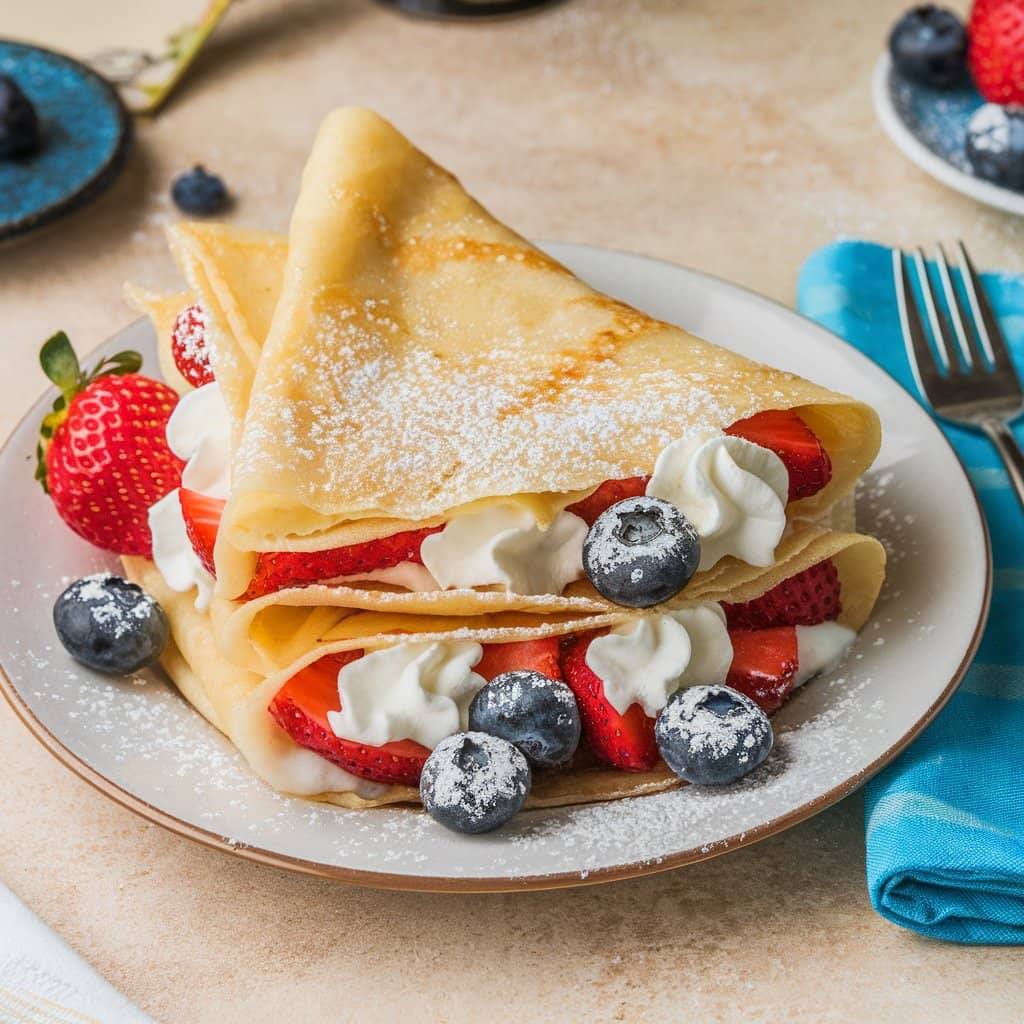
All-Purpose Flour (AP Flour)
All-purpose flour is the top choice for sweet crepes due to its balance of protein and starch. It creates crepes with a tender texture while maintaining enough structure to hold sweet fillings. Its mild flavor complements sugary ingredients.
Why It Works:
- Readily available and affordable.
- Produces light and flexible crepes.
- Works well with sweet fillings like Nutella, jam, and fresh fruit.
Cake Flour
Cake flour’s low protein content (around 8%) results in ultra-soft and tender crepes. It’s ideal for dessert-style crepes with delicate textures. However, its low gluten level means it’s less elastic, so handle the crepes carefully.
Why It Works:
- Creates melt-in-your-mouth crepes.
- Perfect for crepes filled with custard, cream, or sweet sauces.
Pastry Flour
Pastry flour is a middle-ground option between all-purpose and cake flour. It provides softness with a touch of elasticity, making it perfect for sweet crepes that need to hold firmer fillings like fruit compote or caramelized apples.
Why It Works:
- Balances tenderness and structure.
- Adds a light, fluffy texture without being too delicate.
Whole Wheat Pastry Flour
Whole wheat pastry flour is a healthier alternative that still yields tender crepes. Its milder wheat flavor complements sweet fillings without being overpowering. It’s an excellent option for health-conscious bakers.
Why It Works:
- Adds nutritional value with fiber and vitamins.
- Works well with natural sweeteners like honey or maple syrup.
Tips for Sweet Crepe Success:
- Sift the Flour: Sifting prevents lumps and ensures a smooth batter.
- Use Warm Liquid: Mix flour with warm milk or water for a thinner batter.
- Rest the Batter: Allowing the batter to rest for at least 30 minutes improves consistency and reduces gluten activation.
What Is the Best Flour for Savory Crepes? Top Choices for Delicious Results
Savory crepes have a more robust and earthy flavor, pairing well with fillings like cheese, vegetables, and meats. Selecting the right flour ensures the crepes are flavorful, flexible, and able to hold heavier fillings. Here are the best flours for savory crepes:
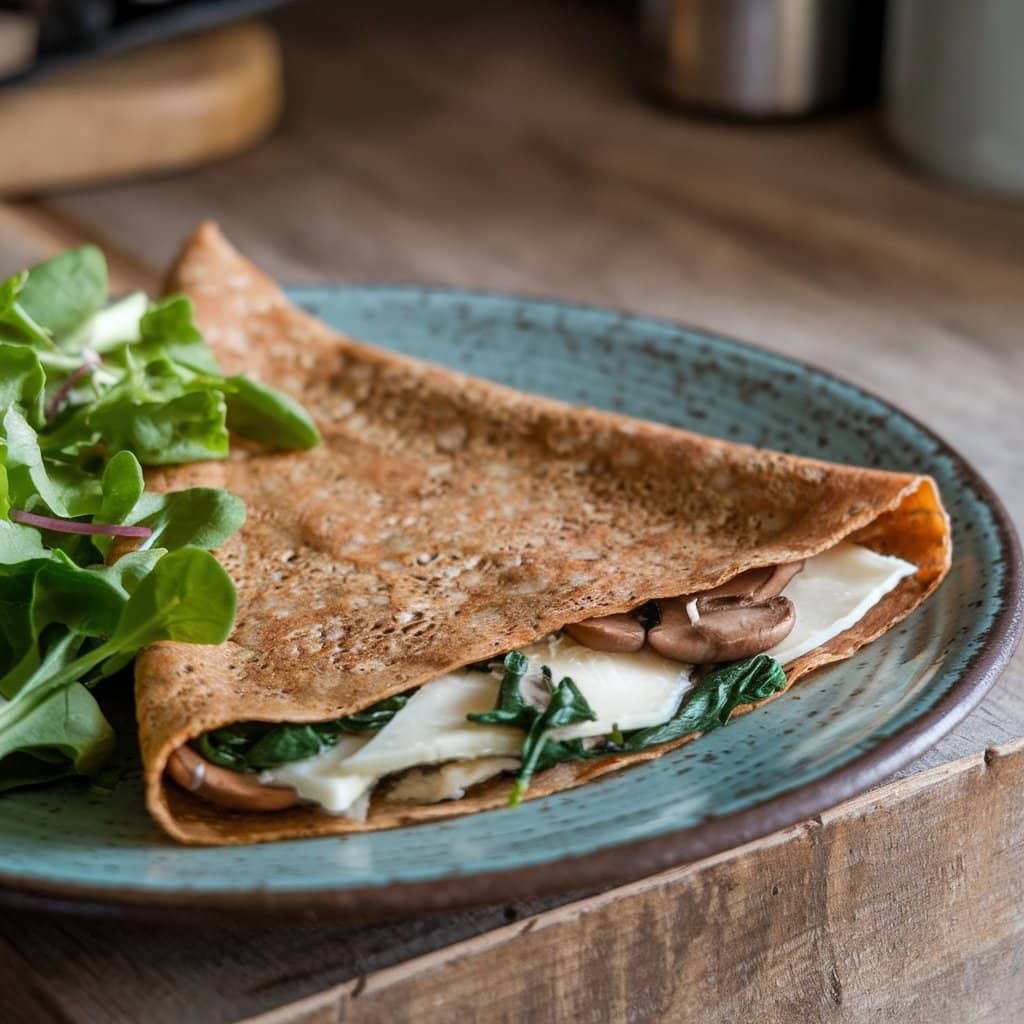
Is Buckwheat Flour the Best Flour for Savory Crepes?
Buckwheat flour is the traditional choice for savory crepes, especially in French cuisine, where it’s used to make “galettes.” It’s gluten-free, high in fiber, and has a unique earthy taste that complements savory fillings like cheese, ham, and spinach.
Why It Works:
- Adds a nutty, slightly bitter flavor.
- Naturally gluten-free for those with sensitivities.
- Creates crispy edges with a chewy interior.
Best Pairings: Eggs, cheese, smoked salmon, sautéed mushrooms.
Is Whole Wheat Flour the Best Flour for Crepes with Hearty Fillings?
Whole wheat flour offers a hearty, nutty taste that enhances savory fillings. Its higher protein content makes it sturdy and filling, though combining it with all-purpose flour can soften the texture.
Why It Works:
- Rich in fiber and nutrients.
- Adds a rustic, wholesome flavor.
Best Pairings: Roasted vegetables, creamy sauces, and meats.
Spelt Flour
Spelt flour is an ancient grain flour with a mild, nutty flavor. It’s more nutritious than regular wheat flour and provides a soft, tender texture while still being sturdy enough for savory crepes.
Why It Works:
- Easy to digest for many people.
- Adds a mild sweetness that pairs well with both savory and slightly sweet fillings.
Best Pairings: Grilled chicken, cheese, and pesto.
Could Chickpea Flour Be the Best Flour for Gluten-Free Crepes?
Chickpea flour is a popular gluten-free option for savory crepes. It’s high in protein and has a distinctive, slightly nutty flavor. It works well in Mediterranean and Indian-inspired crepes.
Why It Works:
- Gluten-free and protein-rich.
- Adds a robust, savory flavor.
Best Pairings: Spinach, feta, olives, and spiced meats.
Rye Flour
Rye flour brings a dense, hearty texture with a bold, tangy flavor. It’s less common but works well for savory crepes with strong, flavorful fillings like smoked meats or sauerkraut.
Why It Works:
- Distinct, tangy taste.
- Great for rustic or gourmet crepe recipes.
Best Pairings: Cured meats, pickled vegetables, and sharp cheeses.
Tips for Savory Crepe Success:
- Blend Flours: Mixing whole wheat or buckwheat with all-purpose flour can improve flexibility.
- Add Herbs & Spices: Enhance the batter with fresh herbs, garlic powder, or black pepper for extra flavor.
- Cook Longer: Savory crepes benefit from a slightly longer cook time for crispy edges and a golden finish.
What Is the Best Flour for Gluten-Free Crepes? Top Alternative Options
For those with gluten sensitivities or dietary preferences, several gluten-free and alternative flours can be used to create delicious crepes. These flours offer unique textures and flavors while keeping crepes light, tasty, and satisfying.
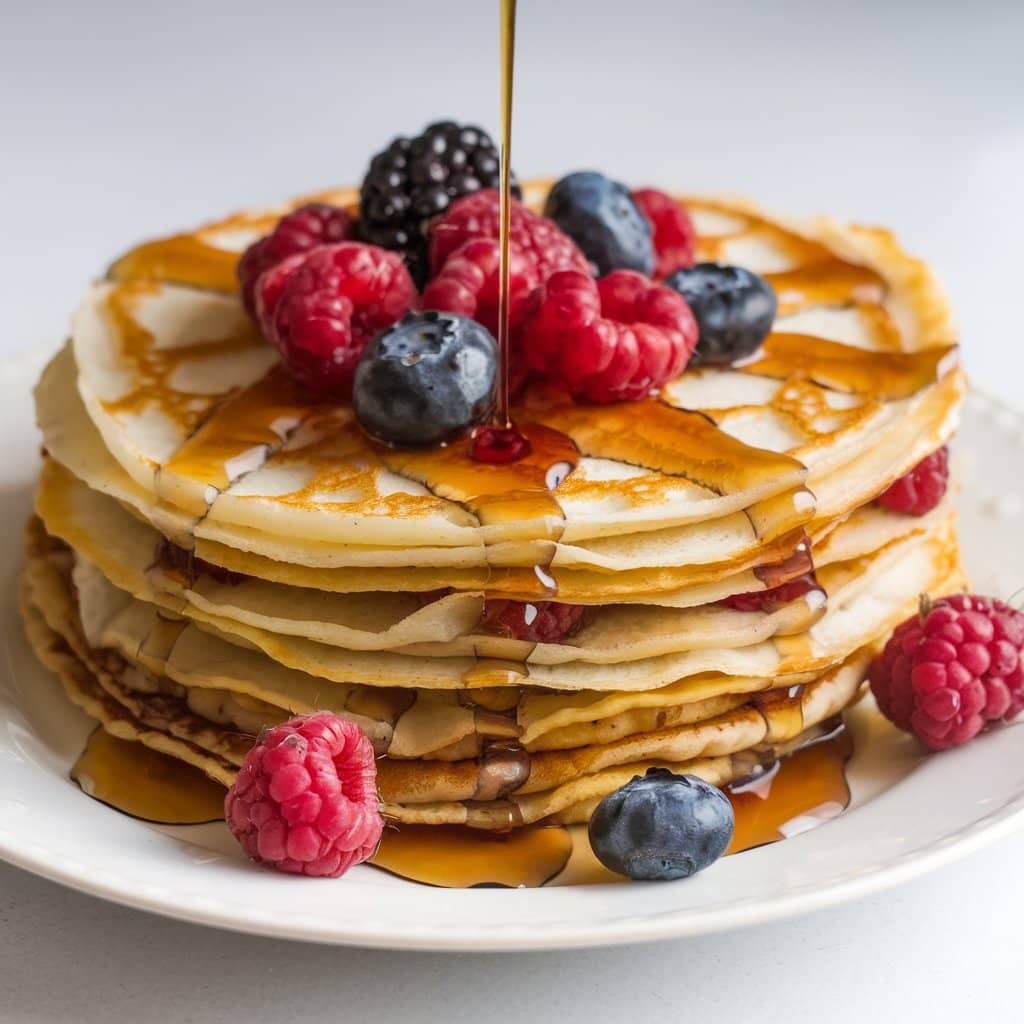
Is Almond Flour the Best Flour for Gluten-Free Crepes? Pros & Cons
Almond flour is a popular gluten-free flour made from finely ground blanched almonds. It adds a rich, nutty taste and pairs well with both sweet and savory crepes. However, because it lacks gluten, almond flour requires binding agents like eggs or starches to hold the batter together.
Why It Works:
- High in protein, fiber, and healthy fats.
- Adds a naturally sweet, nutty flavor.
Best Use: Keto-friendly, low-carb crepes.
Tips: Mix with coconut or tapioca flour for better texture.
Can Rice Flour Be the Best Flour for Light and Crispy Crepes?
Rice flour is another excellent gluten-free option. It has a mild flavor and smooth texture, making it a versatile choice for both sweet and savory crepes. It creates thin and crispy crepes when cooked properly.
Why It Works:
- Neutral taste that works with various fillings.
- Easily available and affordable.
Best Use: Light and crispy Asian-style or dessert crepes.
Tips: Combine with starches like potato or tapioca for extra flexibility.
Chickpea Flour (Besan)
Chickpea flour, made from ground garbanzo beans, has a distinctive, earthy taste and is protein-rich. It is naturally gluten-free and works well for savory crepes. It is common in Mediterranean and Indian cuisines.
Why It Works:
- High in protein and fiber.
- Adds a savory, slightly nutty flavor.
Best Use: Savory crepes with spiced vegetables, cheeses, or meats.
Tips: Use with water or broth for a savory batter base.
Coconut Flour
Coconut flour is a gluten-free flour made from dried coconut meat. It absorbs liquid quickly due to its high fiber content, so only a small amount is needed when making crepes. It adds a light coconut flavor, ideal for tropical-themed or sweet crepes.
Why It Works:
- Naturally gluten-free and low-carb.
- Adds a hint of coconut sweetness.
Best Use: Paleo or keto-friendly dessert crepes.
Tips: Mix with almond or tapioca flour for a more balanced texture.
Tapioca Flour
Tapioca flour, made from cassava root, is an excellent gluten-free option for crepes. It provides elasticity and a chewy texture, making crepes easier to fold and roll. It works well when combined with other gluten-free flours.
Why It Works:
- Adds flexibility and prevents crepes from tearing.
- Has a neutral taste.
Best Use: Gluten-free sweet or savory crepes.
Tips: Mix with rice flour or almond flour for the best consistency.
Sorghum Flour
Sorghum flour is a whole grain flour with a mild, nutty taste. It’s high in protein and fiber, offering a nutritious base for gluten-free crepes. Its texture is similar to wheat flour, making it suitable for hearty and filling crepes.
Why It Works:
- Mild flavor that doesn’t overpower fillings.
- Nutrient-dense and gluten-free.
Best Use: Healthy, whole-grain crepes with vegetable or fruit fillings.
Tips: Use in a blend with tapioca or rice flour for a smoother batter.
for Gluten-Free Crepe Success:
- Mix Flours: Use a blend of gluten-free flours to balance flavor, texture, and flexibility.
- Use Binding Agents: Add eggs, flaxseed meal, or xanthan gum to prevent tearing.
- Rest the Batter: Allow the batter to rest for 20-30 minutes to improve consistency and reduce graininess.
What Is the Best Flour for Crepes? Expert Tips for Choosing the Right Type
Selecting the best flour for crepes involves considering the desired texture, flavor, and dietary needs. Here are expert tips to ensure your crepes turn out light, delicious, and perfectly foldable.
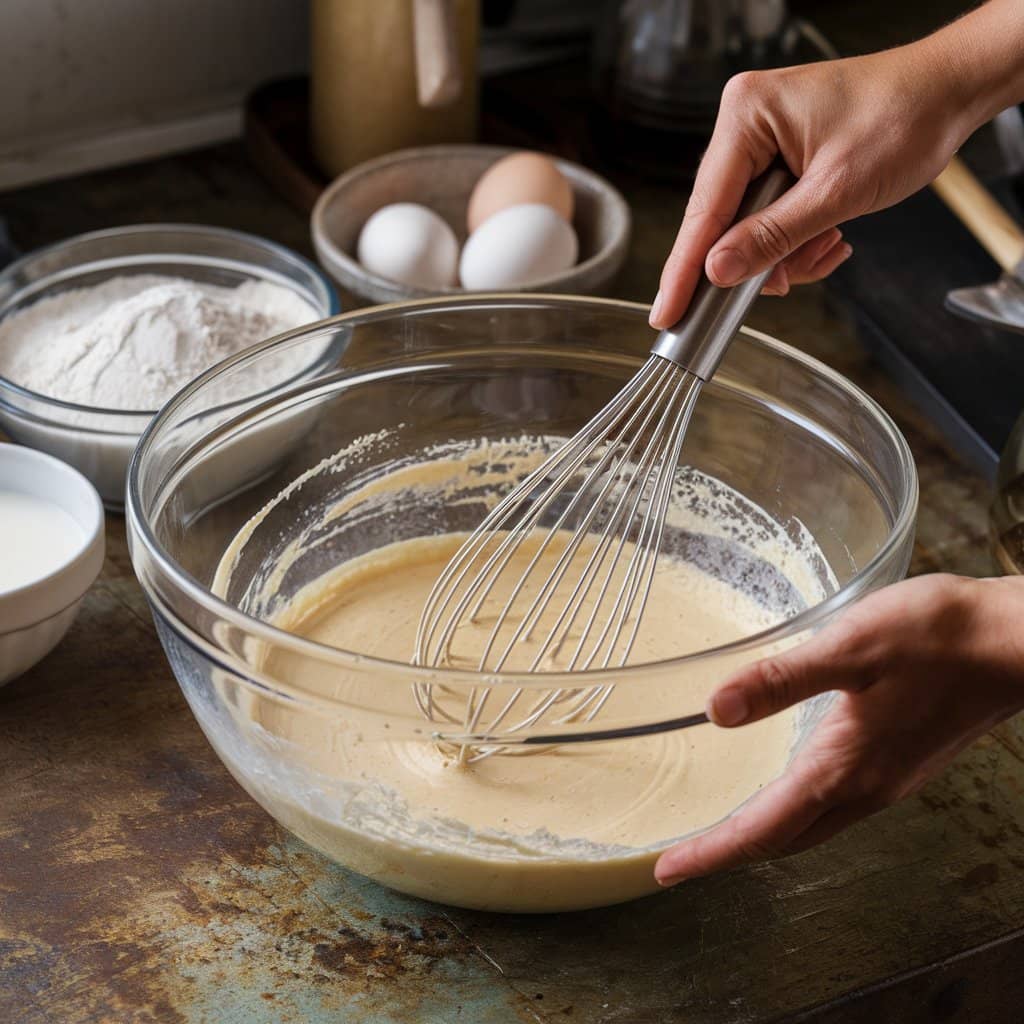
Consider the Type of Crepe You Want
- Sweet Crepes: Use all-purpose, cake, or pastry flour for soft, tender crepes that complement sweet fillings.
- Savory Crepes: Choose buckwheat, whole wheat, or spelt flour for a heartier texture and a slightly nutty taste.
- Gluten-Free Crepes: Use blends of almond, rice, or chickpea flour for a gluten-free alternative with a similar texture to traditional crepes.
How to Blend Flours for the Best Crepes: Expert Flour-Mixing Tips
Combining flours can balance texture, flexibility, and flavor:
- All-Purpose + Buckwheat: For a balanced crepe that’s both flexible and flavorful.
- Rice + Tapioca Flour: This combo improves elasticity for gluten-free crepes.
- Almond + Coconut Flour: Use for keto-friendly or low-carb crepes with a soft, light texture.
Check Flour Freshness
- Smell the Flour: Fresh flour should have a mild, nutty scent. A sour or musty smell indicates spoilage.
- Check the Expiration Date: Always use flour before its expiration date for the best results.
- Inspect for Pests: Store flour in airtight containers to avoid pests and moisture.
Adjust the Batter Consistency
Different flours absorb liquid differently:
- Thin Batter: For lighter, more delicate crepes, increase the liquid slightly.
- Thick Batter: For heartier crepes, use less liquid or add more flour gradually.
Rest the Batter
Resting the batter for at least 30 minutes improves its consistency:
- Why?: This allows the flour to hydrate fully and reduces gluten development, making crepes easier to flip and fold.
Use the Right Equipment
- Non-Stick Pan or Crepe Maker: Prevents sticking and ensures even cooking.
- Crepe Spreader (T-Shaped): Helps spread the batter evenly.
- Flat Spatula: For flipping crepes without tearing.
Experiment with Small Batches
If you’re unsure about a specific flour, make a small test batch:
- Adjust the liquid-to-flour ratio based on how the batter spreads.
- Try different combinations to achieve the best taste and texture.
Common Flour Mistakes to Avoid
- Skipping Sifting: This can cause lumps in the batter.
- Using Expired Flour: It leads to off-flavors and poor texture.
- Overmixing the Batter: This activates gluten, making crepes tough and rubbery.
Storing Flour Properly
- Airtight Containers: Keep flour fresh by storing it in a sealed container.
- Cool, Dry Place: Store flour away from heat, light, and moisture to prevent spoilage.
- Freeze for Long-Term Storage: For extended freshness, store flour in the freezer in airtight bags.
Frequently Asked Questions (FAQs)
Here are some of the most common questions about choosing the best flour for crepes:
What Is the Best Flour for Making Traditional French Crepes?
Traditional French crepes are typically made with all-purpose flour for sweet crepes and buckwheat flour for savory galettes. All-purpose flour ensures a soft, flexible texture, while buckwheat flour adds an earthy, nutty flavor.
Can I Use Gluten-Free Flour for Crepes?
Yes, you can use gluten-free flours such as rice, almond, or chickpea flour. Combining gluten-free flours with starches like tapioca or potato starch improves texture and flexibility.
What Is the Difference Between Cake Flour and All-Purpose Flour for Crepes?
Cake flour has a lower protein content than all-purpose flour, making crepes softer and more delicate. All-purpose flour offers more structure, making it better for fillings that are heavier or more substantial.
Can Whole Wheat Flour Be Used for Crepes?
Yes, whole wheat flour can be used, especially for savory crepes. However, it produces a denser texture. For a lighter result, mix it with all-purpose or pastry flour.
How Do I Prevent Crepes from Tearing?
To prevent crepes from tearing:
- Use a well-rested batter to reduce gluten development.
- Choose the right flour with moderate protein content (like all-purpose or buckwheat).
- Use a non-stick pan and spread the batter evenly.
How Can I Make Crepes More Flexible?
For more flexible crepes:
- Use all-purpose flour or blend it with pastry flour.
- Add an extra egg for elasticity.
- Ensure the batter is slightly thin and rested for at least 30 minutes.
Can I Use Self-Rising Flour for Crepes?
It’s not recommended, as self-rising flour contains baking powder and salt, which can cause the crepes to become too thick and fluffy. Crepes should be thin and delicate, so stick to plain flours.
What Is the Best Flour for Vegan Crepes?
For vegan crepes, try chickpea, rice, or almond flour. Use plant-based milk (like almond or oat) and a binding agent like flaxseed meal or chia seeds for structure.
How Do I Store Leftover Crepe Batter?
Store leftover crepe batter in an airtight container in the refrigerator for up to 2 days. Stir well before using, as the flour may settle at the bottom.
Can I Freeze Cooked Crepes?
Yes, cooked crepes can be frozen. Stack them with parchment paper in between and store them in an airtight container for up to 3 months. Reheat in a skillet or microwave before serving.
Conclusion
Choosing the best flour for crepes depends on your desired texture, flavor, and dietary preferences. All-purpose flour is the most versatile and widely used option, offering a perfect balance of flexibility and lightness. For sweet crepes, cake and pastry flours provide a delicate, tender texture, while buckwheat and whole wheat flours are ideal for savory crepes with robust fillings.

